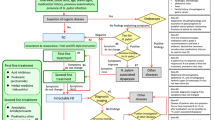Abstract
Backgrounds
The objectives of this study were to delineate differences in the morphologic characteristics of reflux esophagitis between a rat gastroesophageal reflux (GER) model and a duodenoesophageal reflux (DER) model and to evaluate the effects of H2-receptor antagonists on morphologic characteristics of reflux esophagitis in DER model.
Methods
Wistar rats were divided into 3 groups: GER model group (Group G), DER model group (Group D), and control group (Group C). Rats in each group were sacrificed 1 or 12 weeks after surgery. Intraesophageal pH was measured, and the excised esophagus was examined macroscopically and histologically. Subgroups of rats in Group D were given famotidine (10 mg/kg) or lafutidine (30 mg/kg) orally once daily for 1 week after surgery. The rats were then sacrificed, and histological findings were compared.
Results
Intraesophageal pH was significantly lower in Group G than in Group C. At 12 weeks, the epithelium of the lower esophagus in Groups G and D was significantly thicker than that in Group C and showed remarkable hyperplastic changes in Group D. The thickness of the epithelium in Group D + famotidine did not differ significantly from that in Group D. In contrast, the epithelium was significantly thinner in Group D + lafutidine than in Group D.
Conclusions
As a rat model of reflux esophagitis, DER causes severer damage to the esophageal epithelium, including hyperplastic changes, than does GER. Famotidine had no apparent effect on esophageal epithelial damage caused by DER, whereas lafutidine was suggested to attenuate such damage.









Similar content being viewed by others
References
Dent J, El-Serag HB, Wallander MA, Johansson S. Epidemiology of gastro-oesophageal reflux disease: a systematic review. Gut. 2005;54:710–7.
Fujimoto K. Review article: prevalence and epidemiology of gastro-oesophageal reflux disease in Japan. Aliment Pharmacol Ther. 2004;20(Suppl 8):5–8.
Kang JY. Systematic review: geographical and ethnic differences in gastro-oesophageal reflux disease. Aliment Pharmacol Ther. 2004;20:705–17.
Stoker DL, Williams JG. Alkaline reflux oesophagitis. Gut. 1991;32:1090–2.
Caldwell MT, Lawlor P, Byrne PJ, Walsh TN, Hennessy TP. Ambulatory oesophageal bile reflux monitoring in Barrett’s oesophagus. Br J Surg. 1995;82:657–60.
Goldstein SR, Yang GY, Curtis SK, Reuhl KP, Liu BC, Mirvish SS, Newmark HL, Yang CS. Development of esophageal metaplasia and adenocarcinoma in a rat surgical model without the use of a carcinogen. Carcinogenesis. 1997;18:2265–70.
Katada N, Hinder RA, Smyrk TC, Hiki Y, Kakita A. Duodenoesophageal reflux induces apoptosis in rat esophageal epithelium. Dig Dis Sci. 1999;44:301–10.
Miwa K, Sahara H, Segawa M, Kinami S, Sato T, Miyazaki I, Hattori T. Reflux of duodenal or gastro-duodenal contents induces esophageal carcinoma in rats. Int J Cancer. 1996;67:269–74.
Omura N, Kashiwagi H, Chen G, Suzuki Y, Yano F, Aoki T. Establishment of surgically induced chronic acid reflux esophagitis in rats. Scand J Gastroenterol. 1999;34:948–53.
Ichikawa T, Hotta K, Ishihara K. Second-generation histamine H(2)-receptor antagonists with gastric mucosal defensive properties. Mini Rev Med Chem. 2009;9:581–9.
Miyashita T, Miwa K, Fujimura T, Ninomiya I, Fushida S, Shah FA, Harmon JW, Hattori T, Ohta T. The severity of duodeno-esophageal reflux influences the development of different histological types of esophageal cancer in a rat model. Int J Cancer. 2013;132:1496–504.
Jamieson JR, Stein HJ, DeMeester TR, Bonavina L, Schwizer W, Hinder RA, Albertucci M. Ambulatory 24-h esophageal pH monitoring: normal values, optimal thresholds, specificity, sensitivity, and reproducibility. Am J Gastroenterol. 1992;87:1102–11.
Nakano M, Ajioka H, Abe M, Kiniwa M. Possible involvement of host defense mechanism in the suppression of rat acute reflux esophagitis by the particular histamine H2 receptor antagonist lafutidine. Pharmacology. 2012;90:205–11.
Umeda M, Fujita A, Nishiwaki H, Takeuchi K. Effect of lafutidine, a novel histamine H2-receptor antagonist, on monochloramine-induced gastric lesions in rats: role of capsaicin-sensitive sensory neurons. J Gastroenterol Hepatol. 1999;14:859–65.
Holzer P. Neural emergency system in the stomach. Gastroenterology. 1998;114:823–39.
Saegusa Y, Ichikawa T, Iwai T, Goso Y, Ikezawa T, Nakano M, Shikama N, Saigenji K, Ishihara K. Effects of acid antisecretory drugs on mucus barrier of the rat against 5-fluorouracil-induced gastrointestinal mucositis. Scand J Gastroenterol. 2008;43:531–7.
Okayama M, Tsubouchi R, Kato S, Takeuchi K. Protective effect of lafutidine, a novel histamine H2-receptor antagonist, on dextran sulfate sodium-induced colonic inflammation through capsaicin-sensitive afferent neurons in rats. Dig Dis Sci. 2004;49:1696–704.
Akiba Y, Kaunitz JD. Lafutidine, a protective H(2) receptor antagonist, enhances mucosal defense in rat esophagus. Dig Dis Sci. 2010;55:3063–9.
Ethical Statement
The protocol of this study was approved by the Institutional Animal Care and Use Committee of Kitasato University School of Medicine.
Conflict of interest
Takafumi Ichikawa is currently receiving grants from Taiho Pharmaceutical Co., Ltd., Tokyo, Japan. The remaining authors declare no conflict of interests related to this study or publication of this report.
Author information
Authors and Affiliations
Corresponding author
Rights and permissions
About this article
Cite this article
Katada, N., Shibuya, J., Ichikawa, T. et al. Morphologic characteristics of esophageal epithelium in a rat model of duodenoesophageal reflux and protective effect of lafutidine. Esophagus 12, 65–72 (2015). https://doi.org/10.1007/s10388-014-0457-1
Received:
Accepted:
Published:
Issue Date:
DOI: https://doi.org/10.1007/s10388-014-0457-1




